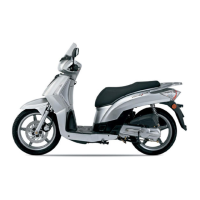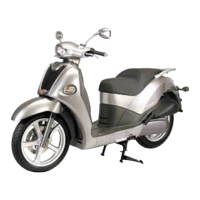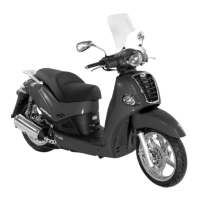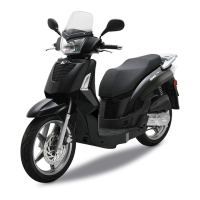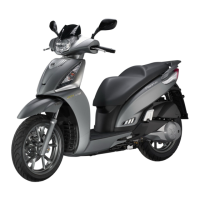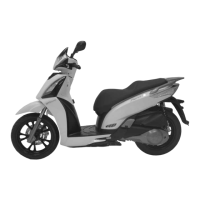Do you have a question about the KYMCO PEOPLE 50 and is the answer not in the manual?
Emphasizes the importance of wearing a helmet for protection against head injuries.
Provides tips on how to increase visibility to other drivers on the road.
Advises riders to stay within their skill boundaries to avoid accidents.
Stresses regular inspection and maintenance for safe riding.
Reminds users to perform a complete safety check before each ride.
Offers advice for riding safely during adverse weather conditions.
Warns against modifying the scooter, which can make it unsafe or illegal.
Details essential protective gear like helmets, eye protection, boots, and gloves.
Explains the importance of helmets and proper fit for head injury protection.
Lists recommended additional protective items for riding.
Specifies the maximum weight capacity for the scooter and its components.
Provides advice on how to properly load the scooter for stability and safety.
Strongly advises against removing or modifying original equipment.
Identifies and illustrates the various parts and controls of the scooter.
Continues the identification and illustration of scooter parts and controls.
Explains how to locate and record the VIN and ESN for identification.
Describes the ignition switch keys and their functions.
Details the operation of the ignition switch and steering lock.
Provides instructions on how to lock the scooter's steering for security.
Explains the procedure for unlocking the scooter's steering.
Describes the function of the engine stop switch.
Explains how to use the electric starter button to start the engine.
Details the functions of switches on the left handlebar.
Explains the operation of the headlight high and low beam switches.
Describes how to use the passing light feature.
Explains how to operate the turn signals.
Details how to use the horn.
Describes the under-seat storage compartment and its weight limit.
Explains the location and use of helmet hooks.
Details how to park the scooter using the main stand.
Explains the various instruments and indicator lights on the dashboard.
Describes the speedometer's function.
Explains the odometer's function.
Describes the fuel gauge and when to refuel.
Explains the clock display and its adjustment.
Identifies the right turn signal indicator light.
Identifies the high beam indicator light.
Identifies the low beam indicator light.
Identifies the left turn signal indicator light.
Provides a step-by-step guide for adjusting the scooter's clock time.
Explains how to adjust the spring preload on the rear shock absorbers.
Describes the passenger foot rests and their function.
Offers guidelines for the initial break-in period to ensure optimal performance.
Specifies throttle limits during the break-in period.
Advises on varying engine speed for proper component mating during break-in.
Warns against prolonged low-speed operation during break-in.
Prohibits full throttle use during the initial break-in phase.
Highlights the importance of the 200-mile initial service.
Provides guidance on breaking in new tires for safe riding.
Offers basic troubleshooting steps for common starting or running issues.
Outlines a routine inspection checklist to perform before every ride.
Instructs on checking the engine oil level and for leaks.
Details checking tire condition and inflation pressure.
Guides on checking and refilling the fuel tank.
Explains how to inspect the front and rear brake systems.
Advises checking steering for smooth operation.
Guides on verifying instrument and indicator light functionality.
Details checking the proper function of lights and horn.
Recommends checking the overall chassis for proper function.
Provides a detailed procedure for inspecting the engine oil level.
Explains how to inspect tire pressure, tread depth, and for damage.
Continues instructions on measuring tire pressure and checking for damage.
Details the procedure for checking and refilling the fuel tank.
Outlines the inspection process for the brake systems.
Describes how to inspect the rear drum brake and its wear indicator.
Continues the brake system inspection, focusing on adjustments and fluid.
Explains how to inspect the front hydraulic brake system.
Details how to inspect the scooter's steering and handlebars for smooth operation.
Guides on checking the functionality of the speedometer, fuel gauge, and indicators.
Outlines how to check the horn, headlight, tail light, and turn signals.
Covers checks for the front suspension, rear shock absorber, and brake lever operation.
Advises checking and replacing reflectors.
Mentions checking and lubricating specific points.
Provides a step-by-step guide for starting the scooter using the electric starter.
Details the procedure for starting the scooter using the kick start lever.
Offers initial advice and safety checks before riding.
Provides instructions and suggestions for parking the scooter.
Explains why proper maintenance is essential for safety and performance.
Presents the maintenance schedule for different mileage intervals.
Explains the symbols used in the maintenance schedule chart.
Provides important notes and clarifications for the maintenance schedule.
Details the specific maintenance tasks required at various mileage intervals.
Provides important warnings and instructions regarding tire maintenance.
Explains the importance of correct tire pressure and how to adjust it.
Recommends engine oil types, capacities, and viscosities.
Details the procedure and importance of changing engine oil.
Guides on how to inspect the engine oil level.
Continues the procedure for checking engine oil level.
Details the procedure for changing the transmission fluid.
Explains how to service the air cleaner filter element.
Provides information on spark plug inspection, cleaning, and replacement.
Guides on inspecting the fuel system and hoses for leaks.
Discusses the maintenance-free battery and its care.
Details the process for battery removal, charging, and installation.
Explains the location and replacement of fuses.
Guides on inspecting wire and cable covers for protection and integrity.
Instructs on checking the front brake fluid level.
Details the procedure for adding the correct type of brake fluid.
Explains how to adjust the rear brake lever free-play and shoe adjustment.
Provides general guidance on cleaning the scooter and avoiding damage.
Details the steps for washing the scooter safely and effectively.
Advises on cleaning the scooter after exposure to road salt.
Provides tips for cleaning and maintaining painted aluminum wheels.
Offers guidance on cleaning the exhaust pipe.
Offers advice for storing the scooter to prevent deterioration.
Details the steps for preparing the scooter for extended storage.
Provides steps for preparing the scooter after storage.
Lists the physical dimensions of the People 50 scooter.
Details the capacities for engine oil, transmission oil, and fuel.
Provides engine specifications like type, displacement, and bore.
Lists chassis details, including tire sizes and suspension types.
Details electrical specifications like ignition type, battery, and lights.
Lists the physical dimensions of the People 150 scooter.
Details the capacities for engine oil, transmission oil, and fuel.
Provides engine specifications like type, displacement, and bore.
Lists chassis details, including tire sizes and suspension types.
Details electrical specifications like ignition type, battery, and lights.
Explains the function of the Clean-Air System in improving exhaust emissions.
Describes the crankcase emission control system.
Explains the exhaust emission control system.
Discusses exhaust noise emission control.
Outlines the terms and conditions of the limited warranty for scooters.
Lists items specifically excluded from the warranty coverage.
Details what the warranty covers.
Specifies the duration of warranty coverage for different parts.
Outlines the owner's responsibilities to maintain warranty coverage.
Lists conditions and damages not covered by the warranty.
Defines KYMCO's liability limitations under the warranty.
Explains the specific legal rights granted by the warranty.
Space to record the ignition switch key identification number.
Space to record the Vehicle Identification Number (VIN).
Space to record the Engine Serial Number (ESN).
Emphasizes the importance of wearing a helmet for protection against head injuries.
Provides tips on how to increase visibility to other drivers on the road.
Advises riders to stay within their skill boundaries to avoid accidents.
Stresses regular inspection and maintenance for safe riding.
Reminds users to perform a complete safety check before each ride.
Offers advice for riding safely during adverse weather conditions.
Warns against modifying the scooter, which can make it unsafe or illegal.
Details essential protective gear like helmets, eye protection, boots, and gloves.
Explains the importance of helmets and proper fit for head injury protection.
Lists recommended additional protective items for riding.
Specifies the maximum weight capacity for the scooter and its components.
Provides advice on how to properly load the scooter for stability and safety.
Strongly advises against removing or modifying original equipment.
Identifies and illustrates the various parts and controls of the scooter.
Continues the identification and illustration of scooter parts and controls.
Explains how to locate and record the VIN and ESN for identification.
Describes the ignition switch keys and their functions.
Details the operation of the ignition switch and steering lock.
Provides instructions on how to lock the scooter's steering for security.
Explains the procedure for unlocking the scooter's steering.
Describes the function of the engine stop switch.
Explains how to use the electric starter button to start the engine.
Details the functions of switches on the left handlebar.
Explains the operation of the headlight high and low beam switches.
Describes how to use the passing light feature.
Explains how to operate the turn signals.
Details how to use the horn.
Describes the under-seat storage compartment and its weight limit.
Explains the location and use of helmet hooks.
Details how to park the scooter using the main stand.
Explains the various instruments and indicator lights on the dashboard.
Describes the speedometer's function.
Explains the odometer's function.
Describes the fuel gauge and when to refuel.
Explains the clock display and its adjustment.
Identifies the right turn signal indicator light.
Identifies the high beam indicator light.
Identifies the low beam indicator light.
Identifies the left turn signal indicator light.
Provides a step-by-step guide for adjusting the scooter's clock time.
Explains how to adjust the spring preload on the rear shock absorbers.
Describes the passenger foot rests and their function.
Offers guidelines for the initial break-in period to ensure optimal performance.
Specifies throttle limits during the break-in period.
Advises on varying engine speed for proper component mating during break-in.
Warns against prolonged low-speed operation during break-in.
Prohibits full throttle use during the initial break-in phase.
Highlights the importance of the 200-mile initial service.
Provides guidance on breaking in new tires for safe riding.
Offers basic troubleshooting steps for common starting or running issues.
Outlines a routine inspection checklist to perform before every ride.
Instructs on checking the engine oil level and for leaks.
Details checking tire condition and inflation pressure.
Guides on checking and refilling the fuel tank.
Explains how to inspect the front and rear brake systems.
Advises checking steering for smooth operation.
Guides on verifying instrument and indicator light functionality.
Details checking the proper function of lights and horn.
Recommends checking the overall chassis for proper function.
Provides a detailed procedure for inspecting the engine oil level.
Explains how to inspect tire pressure, tread depth, and for damage.
Continues instructions on measuring tire pressure and checking for damage.
Details the procedure for checking and refilling the fuel tank.
Outlines the inspection process for the brake systems.
Describes how to inspect the rear drum brake and its wear indicator.
Continues the brake system inspection, focusing on adjustments and fluid.
Explains how to inspect the front hydraulic brake system.
Details how to inspect the scooter's steering and handlebars for smooth operation.
Guides on checking the functionality of the speedometer, fuel gauge, and indicators.
Outlines how to check the horn, headlight, tail light, and turn signals.
Covers checks for the front suspension, rear shock absorber, and brake lever operation.
Advises checking and replacing reflectors.
Mentions checking and lubricating specific points.
Provides a step-by-step guide for starting the scooter using the electric starter.
Details the procedure for starting the scooter using the kick start lever.
Offers initial advice and safety checks before riding.
Provides instructions and suggestions for parking the scooter.
Explains why proper maintenance is essential for safety and performance.
Presents the maintenance schedule for different mileage intervals.
Explains the symbols used in the maintenance schedule chart.
Provides important notes and clarifications for the maintenance schedule.
Details the specific maintenance tasks required at various mileage intervals.
Provides important warnings and instructions regarding tire maintenance.
Explains the importance of correct tire pressure and how to adjust it.
Recommends engine oil types, capacities, and viscosities.
Details the procedure and importance of changing engine oil.
Guides on how to inspect the engine oil level.
Continues the procedure for checking engine oil level.
Details the procedure for changing the transmission fluid.
Explains how to service the air cleaner filter element.
Provides information on spark plug inspection, cleaning, and replacement.
Guides on inspecting the fuel system and hoses for leaks.
Discusses the maintenance-free battery and its care.
Details the process for battery removal, charging, and installation.
Explains the location and replacement of fuses.
Guides on inspecting wire and cable covers for protection and integrity.
Instructs on checking the front brake fluid level.
Details the procedure for adding the correct type of brake fluid.
Explains how to adjust the rear brake lever free-play and shoe adjustment.
Provides general guidance on cleaning the scooter and avoiding damage.
Details the steps for washing the scooter safely and effectively.
Advises on cleaning the scooter after exposure to road salt.
Provides tips for cleaning and maintaining painted aluminum wheels.
Offers guidance on cleaning the exhaust pipe.
Offers advice for storing the scooter to prevent deterioration.
Details the steps for preparing the scooter for extended storage.
Provides steps for preparing the scooter after storage.
Lists the physical dimensions of the People 50 scooter.
Details the capacities for engine oil, transmission oil, and fuel.
Provides engine specifications like type, displacement, and bore.
Lists chassis details, including tire sizes and suspension types.
Details electrical specifications like ignition type, battery, and lights.
Lists the physical dimensions of the People 150 scooter.
Details the capacities for engine oil, transmission oil, and fuel.
Provides engine specifications like type, displacement, and bore.
Lists chassis details, including tire sizes and suspension types.
Details electrical specifications like ignition type, battery, and lights.
Explains the function of the Clean-Air System in improving exhaust emissions.
Describes the crankcase emission control system.
Explains the exhaust emission control system.
Discusses exhaust noise emission control.
Outlines the terms and conditions of the limited warranty for scooters.
Lists items specifically excluded from the warranty coverage.
Details what the warranty covers.
Specifies the duration of warranty coverage for different parts.
Outlines the owner's responsibilities to maintain warranty coverage.
Lists conditions and damages not covered by the warranty.
Defines KYMCO's liability limitations under the warranty.
Explains the specific legal rights granted by the warranty.
Space to record the ignition switch key identification number.
Space to record the Vehicle Identification Number (VIN).
Space to record the Engine Serial Number (ESN).
| Fuel System | Carburetor |
|---|---|
| Ignition | CDI |
| Front Suspension | Telescopic Fork |
| Front Brake | Disc |
| Rear Brake | Drum |
| Front Tire Size | 100/80-16 |
| Rear Tire Size | 120/80-16 |
| Seat Height | 780 mm |
| Width | 700 mm |
| Transmission | Automatic |

